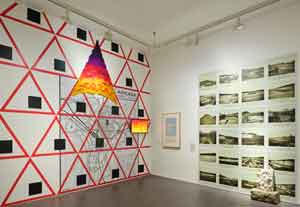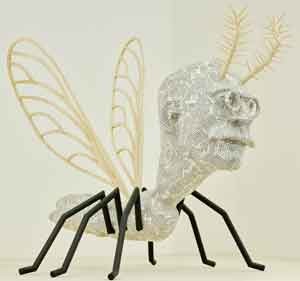By Donal Fallon

Irish historical themes have been present in many recent exhibitions in the Irish Museum of Modern Art (IMMA). Last year’s well-received Patricia Hurl retrospective, The Irish Gothic, positioned deeply personal works alongside pieces like ‘Study for the Kerry Babies Trial’. Now, Self-Determination: A Global Perspective casts a wide net, exploring the emergence not only of the Irish state but also of other new nation states that emerged in the rapidly changing landscape of the 1917–23 world.
This exhibition seeks to explore change ‘against the backdrop of the international movement towards self-determination, most famously articulated by Woodrow Wilson at the Paris Peace Talks in 1919’. Earlier still, Lenin’s The right of nations to self-determination dealt with the emerging and historic ‘National Questions’ of some of the nations explored in this exhibition.

In Ireland there was significant early enthusiasm for the Bolshevik revolution, expressed in the attendance of thousands of people at a 1918 meeting in the Mansion House, with a poster heralding that ‘Russia recognizes Ireland’. In truth, Sinn Féin’s representative Patrick McCartan would later fail to secure Soviet recognition for an Irish Republic. Some of the nations explored in this exhibition welcomed such political changes, believing that they would assist in their own quest for self-determination. Others sought to break their connections with the Soviet world in subsequent years.
Taking into account Finland (1917), Estonia (1918), Latvia (1918), Poland (1918), Ukraine (1917), Turkey (1923) and Egypt (1922), this exhibition presents work by artists who found themselves entangled in the political changes of the time, alongside contemporary work addressing how these societies fared over the subsequent century. Significantly, the exhibition (which was three years in the making) has collaborated with institutions from these nations, with the cooperation of the National Art Museum of Ukraine (NAMU) and the Museum of Theatre, Music and Cinema of Ukraine bringing items to Dublin for display for the very first time. The exhibition has commissioned new works from a broad range of artistic practices and disciplines, but of primary interest to History Ireland readers is undoubtedly what has been brought forward from the archives.
Self-Determination opens with an impressive time-line (available to read in full online), an entire room given over to a chronological journey that takes us from 1913 to 1939, divided into Irish and international dimensions. Far beyond merely covering significant political dates, it also serves as a time-line of Irish modernism and artistic achievement. It highlights the intersections of art and politics throughout various revolutions—the appointment of a minister for fine arts (George Noble Plunkett) by the underground Dáil Éireann was a unique acknowledgement of the importance of the arts. Other things took precedence, of course, as Plunkett learned when his Mansion House Round Room celebration of Dante was overshadowed by the Anglo-Irish Treaty negotiations.
From the collections of the IMMA come some interesting lesser-seen pieces. With national borders a subject returned to throughout the exhibition, we encounter Brian O’Doherty’s 1980 work Modest Proposal, from a time when the artist was using the name ‘Patrick Ireland’, to draw attention to the political crisis in Northern Ireland. A stroll around the gardens of the IMMA today may lead a visitor to the unassuming grave-marker of this alter ego, which O’Doherty symbolically laid to rest, believing that conditions there had changed. His tongue-in-cheek proposal, to relocate the Six Counties across the border and into the midlands, is a playful artistic interaction with the idea of borders and boundaries, ever-present things in the dialogue of other nations too.

For the various national histories explored, there are essentially three periods to each tale: first, the journey towards self-determination; second, the manner in which these new nation states utilised the arts and design to shape their identity; third, artistic responses and challenges to these states. In the case of Ireland, we find the intriguing piece Mosquito Man Arthur by Alan Phelan, a sculpture of the Sinn Féin leader Arthur Griffith in the form of a mosquito, which plays on the underground press (or ‘mosquito press’) of the revolutionary period and Griffith’s censorship-dodging newspaper, Scissors and Paste. Griffith famously wished to ‘mobilise the poets’ in pursuit of Irish self-determination. Later, we encounter the striking work of Seán Keating on the Ardnacrusha scheme. Art historian Eimear O’Connor has spoken of how, to Keating, ‘the whole thing was all about Ireland moving forward into modernity’. Separately, there is also work from contemporary Belfast art collective Array on socio-political issues affecting contemporary Northern Ireland.
While there has been a growing body of academic work placing Ireland’s revolution in its international context, ranging from Darragh Gannon’s exploration of the diaspora in Conflict, diaspora, and empire to comparative studies of the Irish and Finnish civil wars, a cultural and artistic overview like this marks a new departure, demonstrating the shared and differing experiences of new nation states in a time of turmoil and rebirth. The role of art—and of the artist—in the nation-building process is well explored, but so too is the role of the artist as a dissident voice within a state that does not achieve its revolutionary promise in their eyes. Leaving the exhibition, I recalled the words of the actor and 1916 veteran Helena Molony, who spoke in her recollections of how ‘we saw a vision of Ireland, free, pure, happy. We did not realise this vision. But we saw it.’ Self-Determination demonstrates that in other nations there were those like her who felt the same.
Much of the exhibition can still be explored online at www.imma.ie/whats-on/self-determination-a-global-perspective, while the IMMA website also hosts a series of lectures and discussions around the broad themes of the exhibition, including the Turkish artist Iz Öztat discussing her contributions and a series of panel discussions held over three days at the conference ‘100 Years of Self-Determination’.
Donal Fallon is a historian and the presenter of the ‘Three Castles Burning’ podcast.
